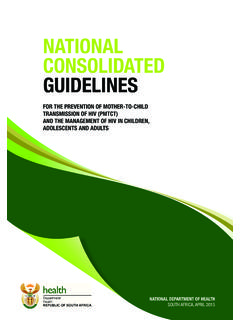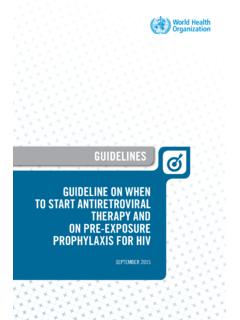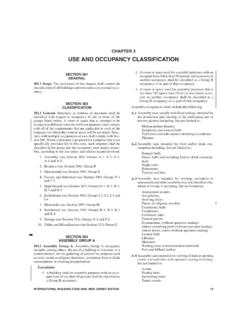Transcription of Post exposure prophylaxis (PEP) & non …
1 post exposure prophylaxis (PEP) & non- occupational post exposure prophylaxis ( npep ) after exposure to HIV Dr Karin Richter Clinical virologist University of Pretoria/NHLS 11 April 2013 What is an exposure ? Percutaneous injury needle-stick or cut with a sharp instrument Contact with mucous membranes Eye, mouth, genital, anal Contact with non-intact skin Chapped, abraded, dermatitis Blood or other potentially infectious body fluids/ tissue possibility of HIV transmission requires consideration of PEP Potentially infectious body fluids At risk Blood Semen Vaginal secretions CSF Synovial, pleural, peritoneal or pericardial fluid Amniotic fluid Not at risk Tears Sweat Urine & faeces Saliva & sputum Nasal secretions Vomitus unless these secretions contain visible blood Case study 1: Brazil 1999 Source: 31 year old - HIV status unknown Injured: 59 year old widowed mother Bit his mother on her hand during a seizure Blood present & mother needed a sutures Dx: Neurotoxoplasmosis & HIV-1 seropositive Mother 27 days later: seroconversion Sequencing of tat gene.
2 Same HIV-1 quasispecies Possibility of transmission by human bite seems to be negligible due to the small number of infecting particles & inhibitors in saliva BUT cases with blood in the biter s mouth may deserve special attention Andreo et al. HIV-1 transmission by a human bite. AIDS Res Human Retroviruses 2004;20:349-50 Case study 2: West Indies 1999 Injured: 52 year old policeman HIV ELISA positive & confirmed by WB HBV: immune HCV: antibodies negative 3 weeks later HCV seroconversion (EIA, RIBA & HCV RNA) Sexual partner HIV & HCV negative 10 weeks earlier: acute mononucleosis-like syndrome 3 weeks before onset of illness (13 weeks before positive HIV test) Punched a man in the teeth while making an arrest Noticed 2 wound on his hand, covered with blood, but did not wash it immediately after the incident Few days later: Lymphangitis requiring antibiotic Rx Man known to be infected with HIV-1, HTLV-1, HBV, HCV 15 months later: HTLV-1 negative Abel et al.
3 occupational Transmission of HIV & HCV after a punch. CID 2000;31:1494-5 Case study 3: Italy 2004 24 year old who had receptive anal intercourse 30 hours earlier with an HIV-infected partner condom rupture HIV ELISA, WB & DNA PCR negative HCV ELISA & WB negative Rx: AZT + 3TC + indinavir for 4 weeks, refused HBV vaccine 3 months later: HIV ELISA negative, but HCV antibodies & RNA positive 6 months later: HIV ELISA negative 8 months later: HIV ELISA, WB & DNA PCR positive Patient denied any further instances of at risk behaviour Suggested that in HIV & HCV co-infection Enhancement of the sexual transmission of HCV Delayed HIV seroconversion PEP failure Terzi R, et al. Late HIV seroconversion after non- occupational PEP against HIV with concomitant HCV seroconversion. AIDS 2007;21(2):262-3 Case study 4: South Africa 2000 At an accident scene near Mooi River toll plaza in 2000 A KZN medical attendant treated an HIV positive pedestrian (who later died) when a Gauteng s car was involved in a crash Without taking the necessary precautions, he then treated the Gauteng who had bleeding wounds High Court 2009-2010 Medical witnesses confirmed that that the Gauteng was probably infected at the time of the accident The judge found that the medical attendant did not take the necessary precautions to prevent infection & held the Health Department liable for any damages Universal precautions should always be taken when handling any potentially infectious body fluid Risk of transmission of HIV Risk varies widely depending on type of exposure For contact with HIV-containing blood, the following infectiousness is assumed Percutaneous: (20/6135) Mucosal exposure .
4 (1/1143) Intact skin: 0% (0/2712) Non-intact skin: (No confirmed cases, theoretical risk) Henderson DK, et al. Risk for occupational transmission of HIV-1 associated with clinical exposures. A prospective evaluation. Ann Intern Med 1990;113:740 Henderson DK. Management of needlestick injuries: a house officer who has a needlestick. JAMA 2012;307:75. Risk of transmission of HIV Risk with exposure to number of viral particles Deep injury A device visibly contaminated with the patient's blood Needle placement in a vein or artery Hollow needle High HIV VL terminal illness in the source patient, acute seroconversion Risk of transmission of HIV Risk of other types of exposure incompletely defined (observational studies) & risk estimates vary enormously Type of sexual act strongly influences level of risk Several co-factors affect risk Source HIV VL Mucosal integrity genital ulcerative disease, genital trauma Immune response at site of transmission other STIs Circumcision ( risk for ) Abers JA, Daskalakis D.
5 Nonoccupational exposure to HIV in adults. Up to date 2013 Risk of transmission of HIV Estimated per act risk for acquisition of HIV Blood transfusion: 90% Needle-sharing IVDU: Receptive anal intercourse: (1/200) Receptive penile-vaginal intercourse: (1/1000) Insertive anal intercourse: (6/10 000) Insertive penile-vaginal intercourse: (5/10 000) Receptive oral intercourse: (1/10 000) Insertive oral intercourse: Abers JA, Daskalakis D. Nonoccupational exposure to HIV in adults. Up to date 2013 Background to PEP/ npep decisions - some basic principles Evidence for PEP & npep PEP guidelines lack a substantive evidence base to guide advice efficacy has NOT been demonstrated by a RCT This will not change: RCT of different drug regimens for PEP are not feasible due to the complexity of exposures relative inefficiency of HIV transmission low event rate inability to ethically have a placebo group SAHIVCS.
6 PEP guidelines. SA J HIV Med 2008 Evidence for PEP & npep What guides decision making? Evolving basic science understanding & biological plausibility Supported by animal model data Retrospective case-control studies of occupational PEP utilizing several ARV regimens PMTCT findings Mayer et al. AIDS 2012;59:354 9 Evidence for PEP & npep Retrospective case-control studies: prophylaxis with a single substance (AZT) decrease the probability of an infection by ~80%* Transmissions despite the use of PEP CDC: occupational HIV transmission to HCWs in the US Up to December 2001 57 documented cases Jan 2002 to Feb 2011 - only one reported case confirmed 143 possible seroconversions (not documented) *Cardo DM, et al. A case-control study of HIV seroconversion in health care workers after percutaneous exposure . CDC Needlestick Surveillance Group. N Engl J Med 1997; 337:1485 post exposure management Immediate management of the exposed area Do Wounds: Wash the exposed site thoroughly with running water Eye or mouth exposure : Irrigate with water or saline Skin: Wash with soap & water, rinse Don t Panic Put the pricked finger in the mouth Squeeze the wound to bleed it Scrub the wound Use bleach, chlorine, alcohol, betadine, iodine or other antiseptics/ detergents on the wound When to initiation PEP?
7 Time is the most important factor Goal: Initiate PEP as soon as possible, preferably within 1 to 2 hours of exposure Best chance to prevent transmission: 24 hours 72 hours: initiating PEP not reasonable Martin LN, et al. Effects of initiation zidovudine treatment at different times after infection of rhesus monkeys with simian immunodeficiency virus. J Infect Dis 1993; 168:825. Determining HIV status of the source PEP starter pack should be initiated while awaiting test results Can do HIV rapid, but confirm with a HIV 4th generation/combo ELISA If the HIV ELISA is negative, but the source patient is at high risk for acute seroconverion: Consider PEP = detect both IgG & IgM antibodies 4th generation Ag/Ab combination assays Ability of screening tests to detect early HIV infection has improved substantially over the past decade Testing & follow up of the injured HIV serologic testing @ baseline, 6 weeks, 3 months & 6 months The majority of individuals who seroconvert will do so within the first 3 months Testing @ 12 months controversial One case report of delayed seroconversion who acquired both HIV & HCV NB.
8 Seek medical advise immediately if any symptoms consistent with acute HIV seroconversion syndrome develops Should the injured acquire HIV infection, HIV can be transmitted to other parties: the greatest risk is the first 6 to 12 weeks Until the 6 month HIV ELISA is negative Avoid blood or tissue donation Avoid breast feeding or pregnancy Avoid unprotected sex abstinence or condom use advised Discontinuation of breast feeding advised Risk reduction counselling Current recommended: 28 days Primate studies with AZT The optimal duration of PEP is unknown Duration of PEP 3 Drugs Less side effects More effective 2 Drugs 2 vs 3 drug regimens Side effect management Incidence of adverse events related to PEP 3 drug regimens: >60% 2 drug regimens containing AZT: >30% Adverse effects are generally not severe Experience suggests that a substantial proportion of individuals for whom PEP is recommended fail to complete their prescribed regimen But: Significantly less side effects with newer ARVs Mayer et al.
9 AIDS 2012;59:354 9 Side effect management A simple, well-tolerated & effective 3-drug PEP regimen could obviate the need to make difficult (and potentially arbitrary) decisions between using 2 drugs or 3 drugs for PEP Mayer et al. AIDS 2012;59:354 9 Preferred ARV regimens for PEP Integration NRTIs NNRTIs Integrase inhibitors Entry inhibitors Protease inhibitors Backbone HIV - PEP Preferred Once a day Tenofovir (TDF) + emtricitabine (FTC) (Truvada ) Alternatives Twice a day Stavudine 30mg (d4T) + lamivudine (3TC) AZT + 3TC (Combivir ) Preferred Twice a day Raltegravir 400mg (Insentress ) Alternatives Once a day Atazanavir (Reyataz )/ritonavir Darunavir (Prezista )/ritonavir Efavirenz 600mg (part of FDC) Rilpivirine (part of Complera ) Twice a day Lopinavir/ritonavir (400/100) (Aluvia 2 tabs) Current 1st line recommendation Raltegravir 1 tablet (400mg) twice a day Truvada * 1 tablet once a day *Fixed-dose combination of 300mg tenofovir DF (TDF) & 200mg emtricitabine (FTC) Truvada (Tenofovir + Emtricitabine) When NOT to take.
10 Absolute contra-indications Previous hypersensitivity to the drug(s) Relative contra-indications Kidney disease used cautiously with any drugs that can cause renal toxicity (cause kidney problems) Truvada (Tenofovir + Emtricitabine) Side effects Diarrhoea Nausea & vomiting Flatulence Dizziness Fatigue Headache Rash of change in skin colour Insomnia Emtricitabine Raltegravir Advantages Site of action Safe Efficacious Excellent tolerability Not affected by food Rare drug interactions For npep : concentrations in the female genital tract than PIs & NNRTIs Not current 1st line ART Disadvantages Twice a day dosing Side effects Rare cases of a severe systemic-cutaneous reaction resembling Stevens-Johnson syndrome Cost Acquir Immune Defic Syndr 2012;59:354-9 *The Fenway Institute, Fenway Health, Boston, MA; Departments of Psychiatry, Harvard Medical School/Massachusetts General Hospital, Boston, MA; and Department of Epidemiology, Harvard School of Public Health, Boston, MA.













